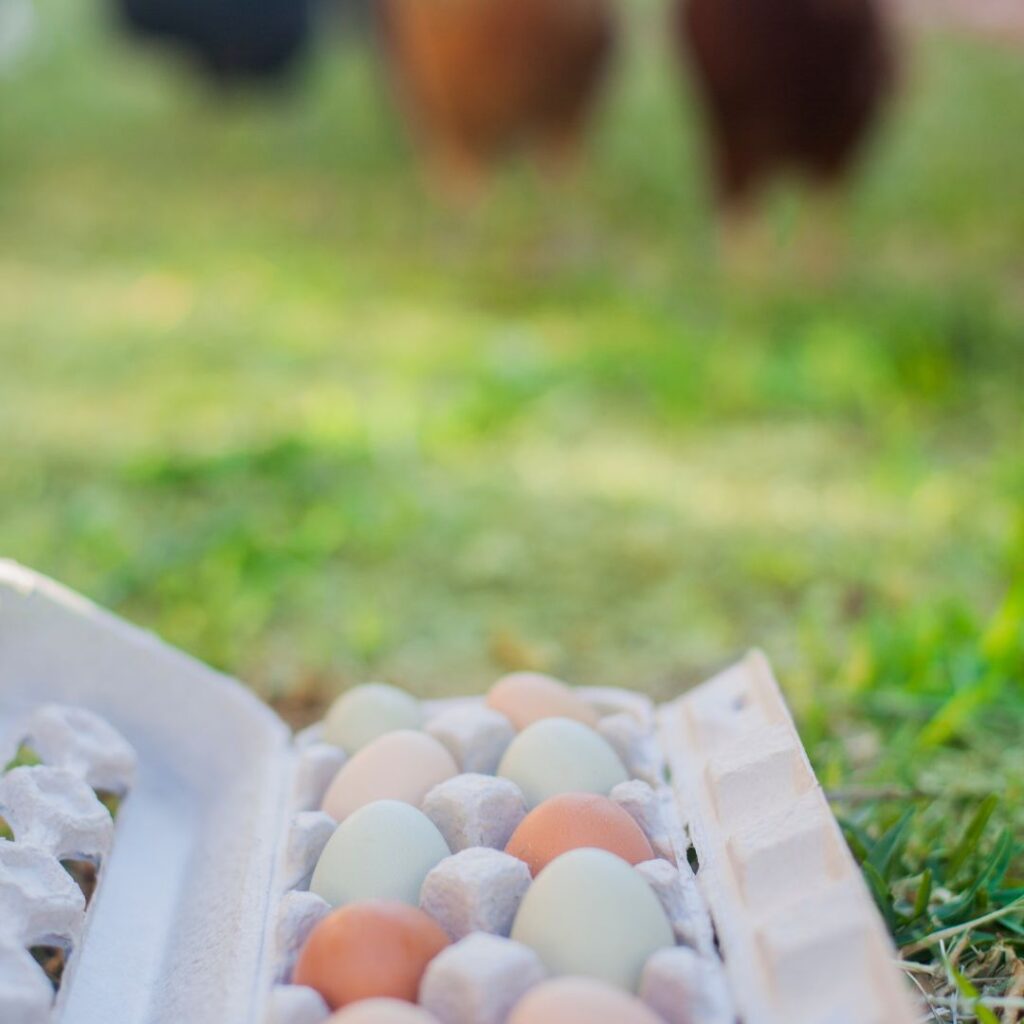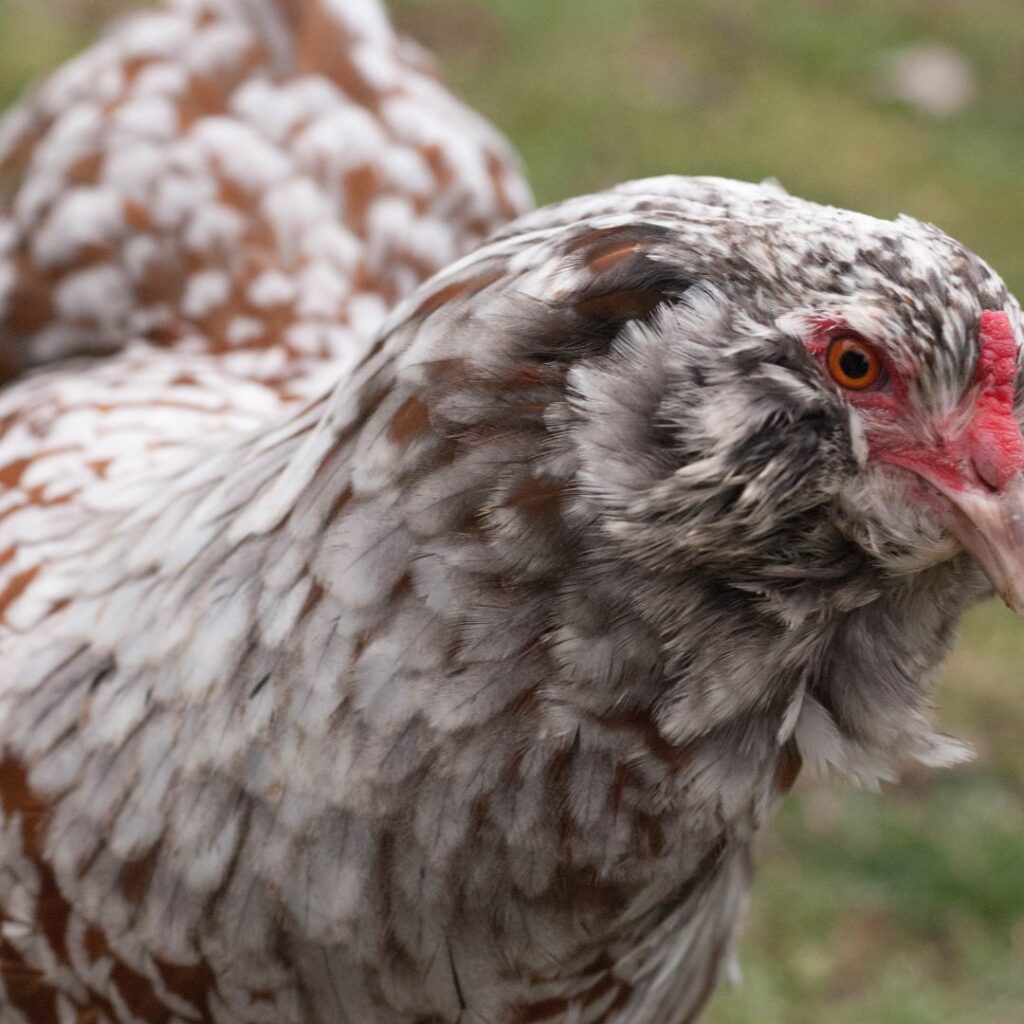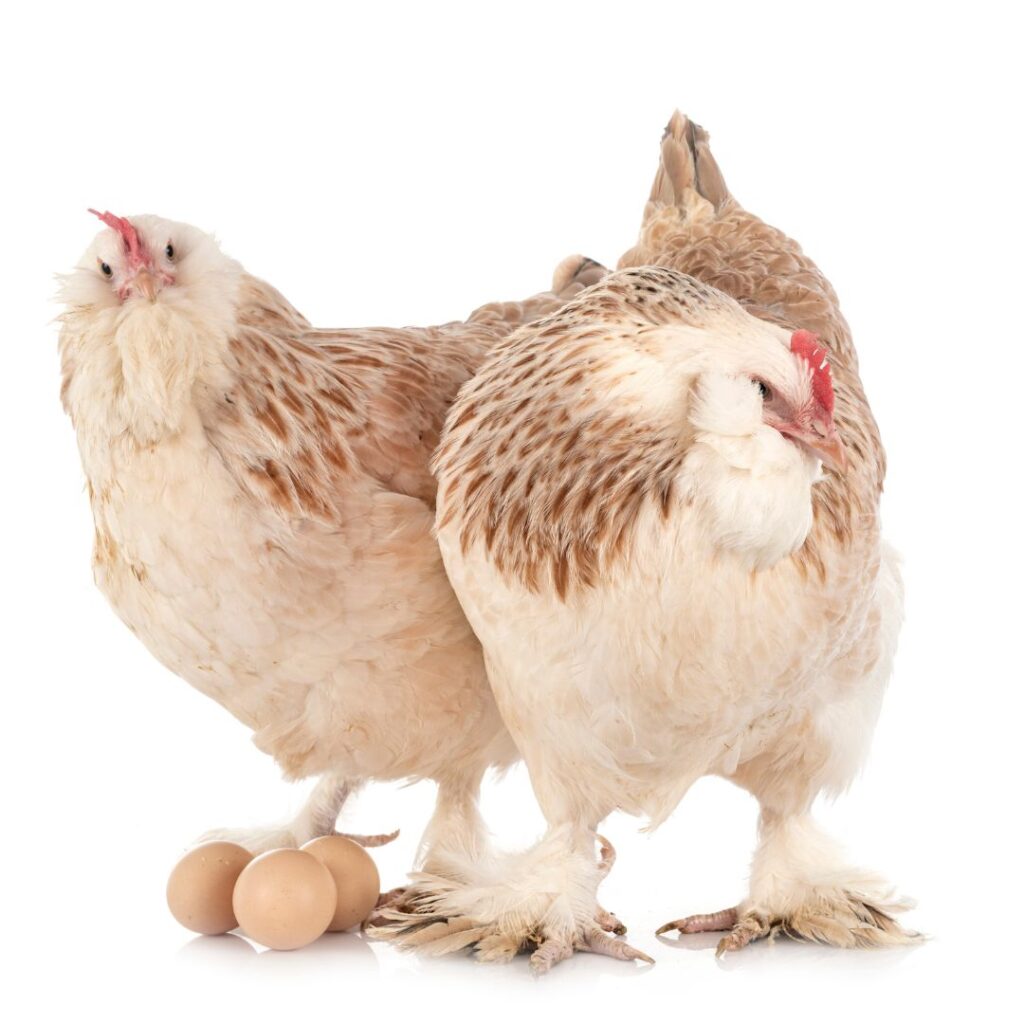The Speckled Sussex chicken is a beautiful bird popular among backyard chicken keepers and hobby farmers. This dual-purpose chicken is known for its egg-laying ability and its meat. In this article, we explore the history, appearance, and personality of the Speckled Sussex chicken.
We will also cover some practical aspects of keeping these chickens, such as their cold hardiness and egg production. So, if you’ve been thinking about adding some Speckled Sussex chickens to your flock, you’ll know if this is the right chicken for you by the time you’re finished reading all these interesting Sussex chicken fun facts.

History Of The Speckled Sussex Chicken
While it’s unclear when the speckled variety first appeared, records from the Roman invasion of Britain indicate that a similar chicken was present in England centuries ago.
The Speckled Sussex chicken is thought to have originated in England in the 1800s.
In Victorian times, owning fancy poultry was all the rage. “Hen fever” swept through the UK and US, with people spending large sums of money on exotic fowls to compete in poultry shows.
One such bird was the speckled Sussex chicken breed (or Kentish fowl), first exhibited at a show at Regent’s Park London Zoo in 1845.
Originally raised for its tasty meat in Sussex and Kent, this chicken quickly gained popularity for its beautiful appearance.
The Speckled Sussex was first admitted into the Standard of Perfection with the American Poultry Association in 1874. The breed became quite popular in America in the early 1900s and was one of the most common breeds kept by farmers and homesteaders.
However, by the mid-1900s, the popularity of the Speckled Sussex had declined sharply. Thankfully, a few dedicated poultry keepers kept the lines going and greatly improved the stock.
This breed has played an important role in supplying meat and eggs for our historical diets. Originating in southeastern England, these chickens were raised for their hearty meat and large eggs.
This trend continued until World War II when the speckled Sussex, along with the other Sussex varieties and Rhode Island Reds, were crucial in keeping Britain supplied with these essential protein sources during wartime shortages.
Today, while they might not have such a pivotal role in our food system, the speckled Sussex remains a popular choice among poultry enthusiasts for its attractive coloring and calm demeanor.
The Appearance of the Speckled Sussex
The Speckled Sussex is a beautiful breed of chicken known for its distinct coloring. They have deep red wattles, earlobes, and combs. The Speckled Sussex has a horn-colored beak, four toes, and a single comb on its head.
Their unique feathering adds to their visual appeal – a glossy mahogany brown base with white and black accents along each feather. And as they age, their speckled pattern becomes even more pronounced after each molt.
Their feathering is a glossy mahogany brown base with some white-tipped feathers, and their wings have a black stripe separating the brown and white. This camouflage feathering helps protect them from predators in the wild. As they age, their speckled pattern becomes more prominent with each molt.
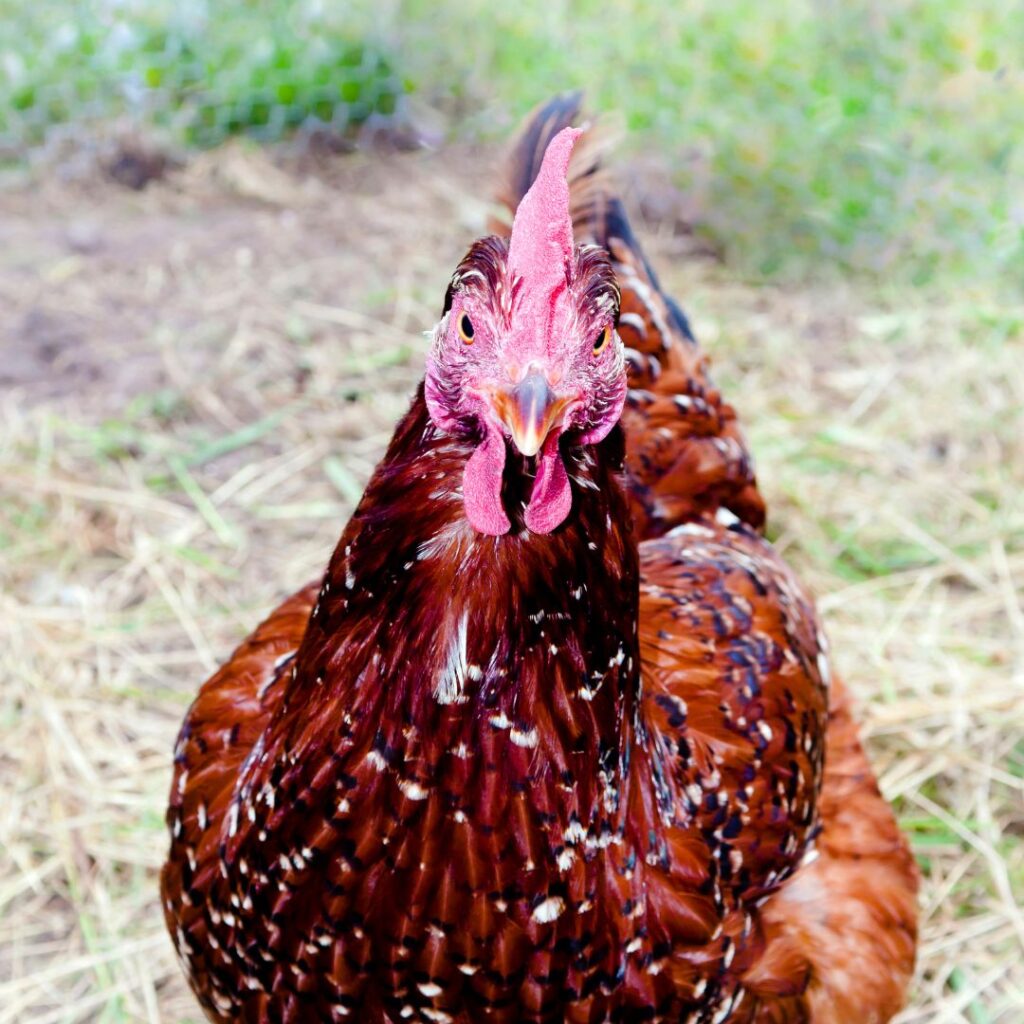
The average weight of a full-grown Speckled Sussex chicken is around 9 pounds for roosters and 7 pounds for hens. Speckled Sussex pullets weigh 6 pounds, and Cockerels are closer to 7.5 pounds.
Keep in mind, however, that they tend to be slower growers than some other breeds due to their large size – but as far as we’re concerned, it’s worth the wait.
Overall this is a chicken with a striking appearance and hardy nature.
Is The Baby Speckled Sussex Chick Born With Speckles?
Sussex chicks can have dark striped markings around the eyes. These markings may vary in intensity from chick to chick, but they will always be present. The backs of baby chicks have light and darker brown stripes.
Shades vary among the baby-speckled chicks. The babies begin to ‘feather,’ showing their wings early on.
The beautiful speckled marking will show against the down of their bodies, making the speckled Sussex chicks even more precious.
how to sex speckled sussex chicks
At hatch, they look like adorable yellow chicks with brown stripes. It’s difficult to identify for the average chicken owner until chicks are around 4-6 weeks old. These are not auto-sexed or sex-linked breeds. This is why most hobby farmers stay away from straight runs (to avoid too many roosters). They leave the sexing to the experts.
As they age, male Speckled Sussex chickens have a distinctive chipmunk pattern. Females have similar coloring but without the chipmunk pattern.
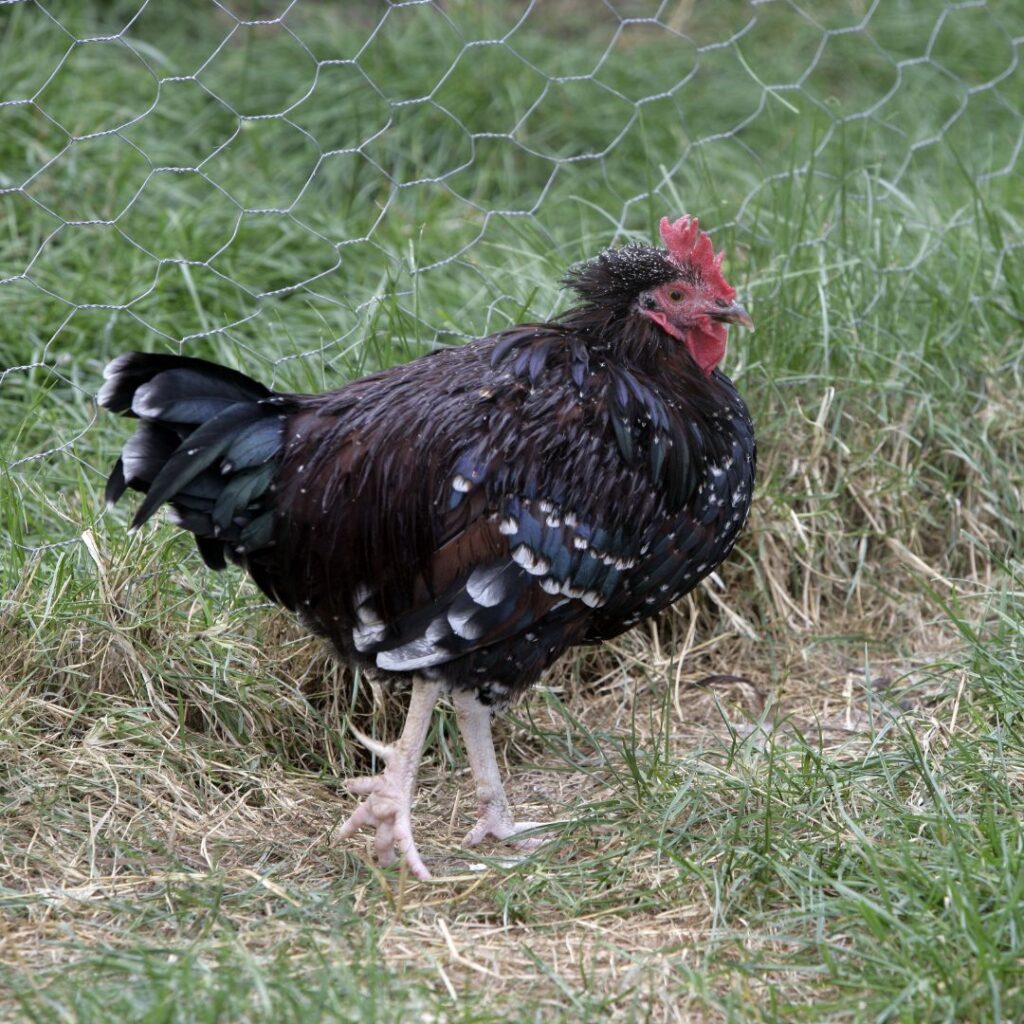
Breed Variations
There are eight recognized color variations of the Sussex breed:
- Light Sussex (APA and BPA)
- Red Sussex (APA and BPA)
- Speckled Sussex (APA and BPA)
- Brown Sussex
- Silver Sussex
- Buff Sussex
- Coronation Sussex
- White Sussex
- Sometimes all these are referred to as spotted Sussex Chickens
There’s no denying these are unique and beautiful birds.
The American Poultry Association only recognizes the light, red and speckled Sussex. Other variants are recognized by the APA and the British Poultry Association.

Brown Sussex Chicken
Recognized by the British Poultry Association, Brown Sussex females (hens) have brown heads and necks featuring a black stripe in almost every feather. Their back and wings are dark brown with black accents, while their breast and lower body have a light brown hue.
Males (roosters), on the other hand, have dark mahogany heads and necks with black stripes in their feathers. They also have mostly mahogany backs and wing bows with bluish-black, black, and brown accents. These birds also possess horn-colored beaks and black tails.
Buff Sussex Chicken
At this time recognized only by the British Poultry Association.
These stunning birds have buff-colored feathers on their heads, necks, wings, and bodies, with greenish-black accents adding a touch of dimension. Both males and females sport this gorgeous coloration.
Coronation Sussex Chicken
This variety is presently only recognized by the British Poultry Association.
The Coronation Sussex chicken is a unique breed recognized by the British Poultry Association. As its name suggests, this variety has distinct shades of blue mixed into its feathers. The male and female both have white heads and necks, with blue stripes in the middle of each feather. The wings are white with blue accents, and the tail is entirely blue. The rest of their bodies are white. This beautiful bird is similar to a Light Sussex chicken but has distinctive blue hues instead of black ones.
Light Sussex Chicken

The American and British Poultry Associations recognize this distinct breed of chicken.
The hen and rooster possess the same coloration in the Light Sussex chickens. Their heads and necks are white with bold black stripes, their wings are white with black accents, and their tails are purely black. The remainder of their bodies, including their beaks, are completely white. It is believed that the Brahma, Cochin chicken, and Silver Grey Dorking breeds were used in developing this Light variety.
Red Sussex Chicken
This chicken breed has been recognized by both the American Poultry Assoc. and the British Poultry Association.
The Red Sussex chicken is known for its gorgeous, distinct coloration. Both male and female Red Sussex have red heads and necks striped with black and dark red bodies and wing bows without the black stripes. The remaining wing feathers have black accents, and their tails are a combination of black and dark red. Underneath, their plumage is slate in color, and their beaks are typically horn-colored.
Silver Sussex Chicken
While the Silver Sussex may be less common in the United States, they’re well-recognized by the British Poultry Association.
These beautiful hens boast a white head, neck, and a black striped saddle with white accents. Their backs and wing bows are gray with silver lacing, and their breasts and thighs have a charcoal coloration with white shafts and silver outlining.
Likewise, roosters have a silvery-white back and black breasts featuring white shafts and silver lacing. They have stunning plumage. They have dark gray thighs, black tails, and a grey-black and white under color; these chickens will turn heads in your coop or backyard.
Both sexes have dark grey thighs with light lacing and black tails. The under-feathering of the female and male is grey-black and white.
White Sussex Chicken
The British Poultry Association is the only organization that currently recognizes this variety.
Both female and male Sussex chickens’ plumage is pure white from top to bottom, including their skin color.
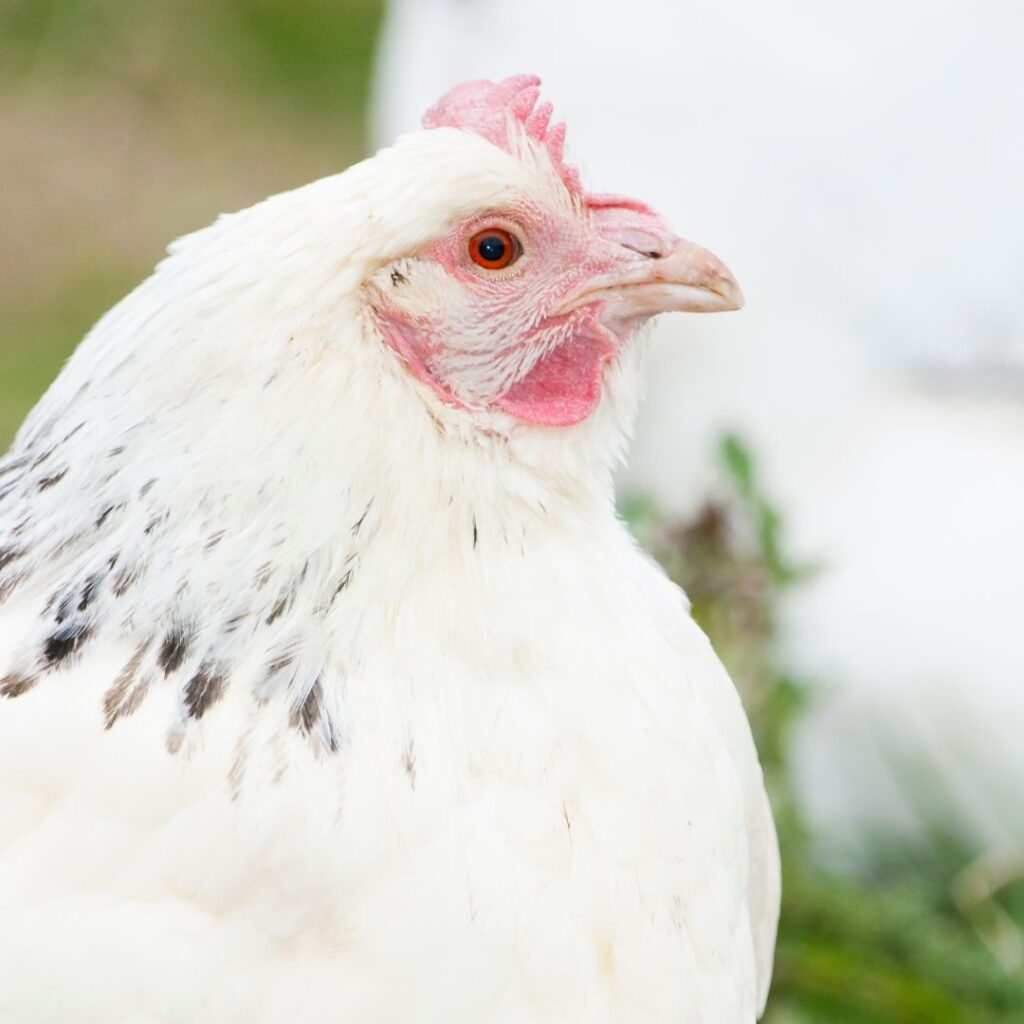
What Is A Speckled Sussex Ranger?
The Speckled Ranger is a hybrid and new to the chicken world. The hens are dark grey and white mottled. They were created by crossing a Rhode Island Red rooster with a Marans hen.
Also known as Speckledy. Hen’s eggs are a rich chestnut brown, often with speckles on the shells.
They are docile, making them great pets. They are also great for free-range flocks.
mystic maran vs black copper maran
The Mystic Mars is a hybrid chicken created by cross-breeding Black Copper Marans roosters with the Plymouth Barred Rock hens. They were created with the goal of extra-large dark brown eggs.
Speckled Sussex Temperament and Personality
These birds will approach you eagerly, seemingly excited for attention and affection. They are also very calm, allowing for easy handling without any fuss.
But don’t let their docile temperament fool you – Sussex chickens are not lazy or dull. They have plenty of energy and are alert to potential predators and other dangers.
They almost make you want to get out and do your backyard chores so that you can be with them. Sussexes also make good pets for children who want to learn about raising chickens.
speckled sussex rooster vs hen; The Pecking Order?
If you’re considering adding Sussex chickens to your coop, it’s important to consider their personality. If ever asked “are Speckled Sussex roosters mean”(also called spotted Sussex Rooster)? The answer is an easy NO. As a breed, Sussex chickens tend to be non-aggressive, and even the roosters have a reputation for being mellow.
They prefer a peaceful environment and may not do well in a coop with pushy or aggressive breeds. These gentle birds often wind up at the bottom of the pecking order and may suffer from bullying if placed in the wrong situation.
When introducing them to your flock, monitor their interactions and separate any aggressive birds that may pose a threat.
If considering options for non-aggressive birds, consider other chicken breeds like the Australorps, Brahma, Buff Orpington, Wyandottes and Cochin. These chickens all do well in backyard flocks and are considered friendly enough to keep as pets.
Avoid mixing your speckled Sussex with chicken breeds like the Rhode Island Reds, Barred Rocks, or other more assertive breeds.
Providing plenty of space and giving attention equally among your chickens will help keep peace in the coop and allow your Sussex chickens to thrive.
Are They Noisy Chickens?
These chickens aren’t loud, but they chat it up quite well. If you’re lucky enough to bond with your speckled Sussex chickens, you may find them following you around and telling you about their day.
They will turn up the volume to announce an egg coming your way, though, and surely will get louder if a predator approaches.

Speckled Sussex Hens; Egg Production
In addition to being a lovely addition to your flock, the speckled Sussex is also a reliable producer of eggs. These hens typically begin laying around 20 weeks of age, with an average production of four or five eggs per week. That amounts to up to 240 eggs per year.
Of course, individual birds may lay more or less, and external factors such as weather can also affect egg production.
The speckled Sussex’s reputation as a dependable layer of large light brown eggs makes them a popular choice for backyard chicken keepers and commercial producers. Keep your girls happy and healthy with plenty of space to roam and regular access to nutritious food and clean water, and enjoy gathering fresh eggs from your speckled Sussex flock.
Is Speckled Sussex Egg Speckled?
Egg color from your sussexes, including the speckled Sussex hen, are light brown. These hens lay large eggs.
Fun Fact: Hens will occasionally lay very small, tiny eggs on their first egg or two, these have been called ‘fairy eggs’ by others, and they’re quite precious to see. This can also happen when your hen comes out of its molt and starts to lay again.
Read About Reasons Chickens Stop Laying Eggs
Are The Speckled Sussex Hens Broody? Are They Good Mothers?
The Speckled Sussex hen is known for its tendency to go broody, making it a great choice for those looking to hatch their eggs. These hens are also known for their nurturing nature, making them excellent mothers for their chicks. When broody, the Speckled Sussex is a reliable and diligent sitter, producing strong and healthy offspring. Read more about the best and worst breeds of broody hens here.
Their broodiness and motherly instincts make the Speckled Sussex chicken a great choice for small backyard flocks looking to hatch their own Speckled Sussex chicks. If you’re interested in adding baby chicks to your flock or a hobby farmer looking to raise chickens for sale, the Speckled Sussex breed is an attractive option.
You can find out more about how long your hen will lay eggs for here.

Do The Speckled Sussex Make Good Meat Birds?
The Sussex chickens were originally bred as dual-purpose birds for meat and egg production. Today they are widely known for their egg production more than their meat.
However, their meat production may be slower-growing than other broiler poultry breeds. It takes them about 20 weeks to reach full maturity, much longer than breeds specifically bred for meat production, like the Cornish Cross.
The Speckled Sussex offers a tasty alternative for backyard chicken enthusiasts looking to raise meat birds. It has a good amount of flavor with a decent amount of dark meat. Overall, the Speckled Sussex breed may not produce as much meat as some industrial breeds but is still a solid choice for homegrown, pasture-raised poultry.
Plus, their eggs are delicious too! So why not give this heritage breed a try in your flock? You may be pleasantly surprised by what these speckled cuties have to offer on your dinner table.
Are The Speckled Sussex Chickens A Good Free-Range Chicken Breed?
They aren’t just pretty; they also make great free-range chickens. The Speckled Sussex chicken breed is known for its robustness and hardiness, meaning it can handle outdoor living in various climates.
They are also good foragers, finding a fair amount of their food while free ranging around the yard.
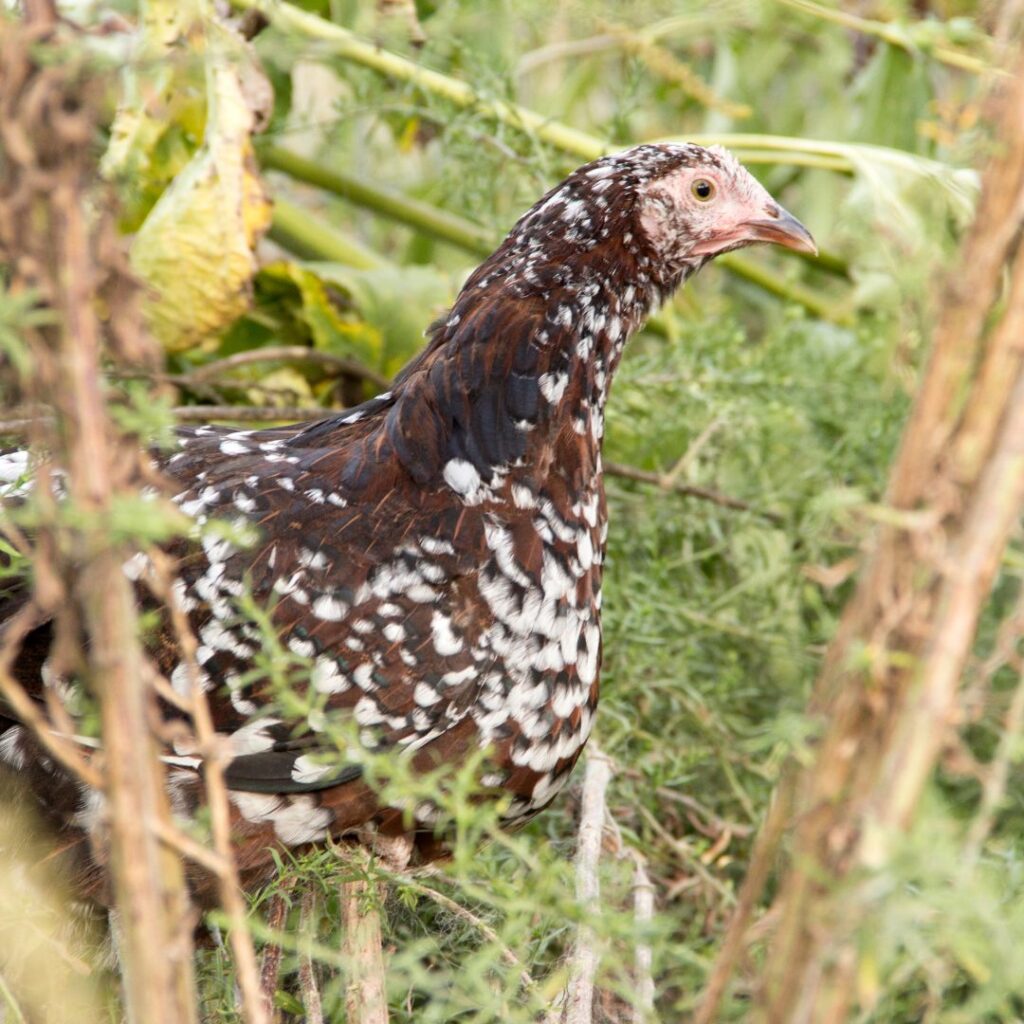
How Are Sussex Chickens For Urban Chickens (City Chickens)?
Although the Sussex breed is a lover of the great outdoors and free-ranging, they can equally handle confinement well with adequate space in their chicken coop as well as their run area.
They are not ‘loud’ but chatty, making them worth considering for an urban flock.
If you’re limited on space and want to start with a small chicken, consider looking into a Mille Fleur D’Uccle Bantam Breed or the Silver or Golden Sebright Bantam.
How Are Sussex In Cold Weather?
The Speckled Sussex chicken breed is a livestock breed known for its hardiness and ability to lay plenty of large, brown eggs. The speckled Sussex hens fare well in cold climates and will continue laying throughout the winter.
However, a Speckled Sussex rooster may experience some issues with frostbite on their large combs; extra care should be taken to protect them from harsh weather conditions. Add some petroleum jelly to protect the combs of your Speckled Sussex Rooster, which will go a long way towards protecting from frostbite.
Speckled Sussex chickens are particularly well adapted for colder temperatures, making them a great choice for those in more northern regions.
Overall, Any variety, including the stunning Speckled Sussex, makes great additions to any flock and their cold hardiness only adds to their appeal as a reliable and productive poultry breed.

The Chicken Coop and Run area.
- Each bird needs approximately four to six square feet of space inside the coop and ten to fifteen square feet in an outdoor run. Some chicken breeds need more space, but it’s always safe to go with more room.
- The Requirements for an Acceptable Chicken Coop: Properly and easily accessible for cleaning and caring for your chickens.
- Keep your flock comfortable during the winter by preparing their coop ahead of time. Ensure the coop is ventilated to get rid of extra moisture, has enough bedding material for insulation, and has no cracks or holes that would let in cold drafts. Read more about chicken care during winter months here.
- Good ventilation will also assist in mitigating moisture and heat issues during summer.
- Perch Requirements: Chickens need approximately eight to twelve inches of perching space each. Different chicken breeds may need less space. They will spread out more to keep cool and huddle closer together in the winter to keep warm. Perches are also a nice place to ‘get away from the flock for some ‘me time
- Nesting boxes: Each flock of chickens should have one nesting box per four hens. These should be the standard 12×12 size. A nice-sized nesting box will allow for a safe place to lay their nice large brown speckled eggs and set on their eggs to hatch a speckled Sussex chick to enjoy.
- Feeders and Waterers: Ensure that their food and water are clean and fresh daily.
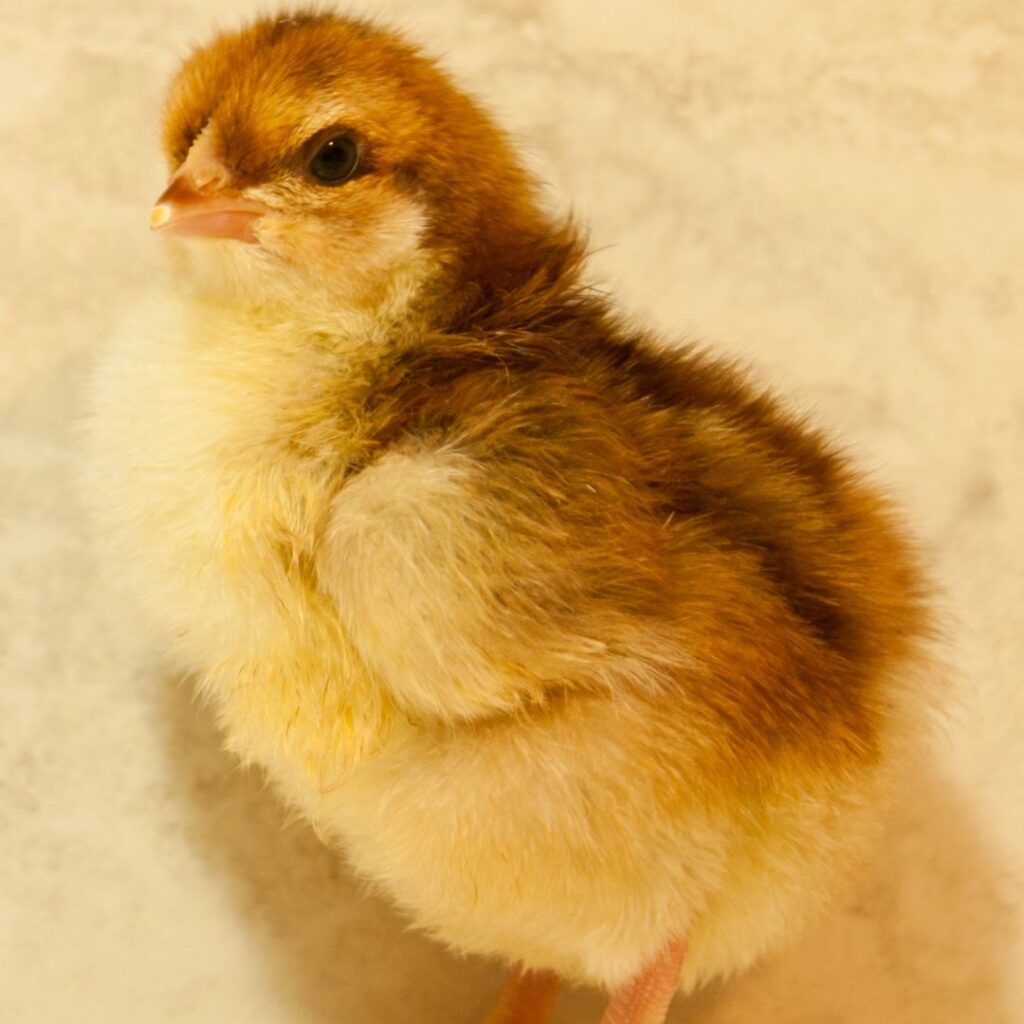
- Since water freezes quicker in the winter, you’ll have to change your water more often. To save some hassle, buy a heated waterer or bowl warmer. Remember that this would require a safe power source near your coop.
- Shelter from the elements should be provided in the run area. A tarp or shade cloth to stay cool in the summer and a lean-to or tent for shelter from snow and rain.
- Fencing height: Always ensure your chicken run is no less than 6 feet, enclosed with chicken wire or a fence that will block predators and allow birds to stay in. Before adding any chickens into the space, check that there are no gaps in the fencing that they could escape through.
- Predators: Keep your chickens safe from predators such as foxes, coyotes, hawks, and fisher cats; it is important to ensure their coop is predator-proof. The top of the run should be made out of sturdy material like wire mesh or hardware cloth. The door should also have a secure latch that predators cannot open.
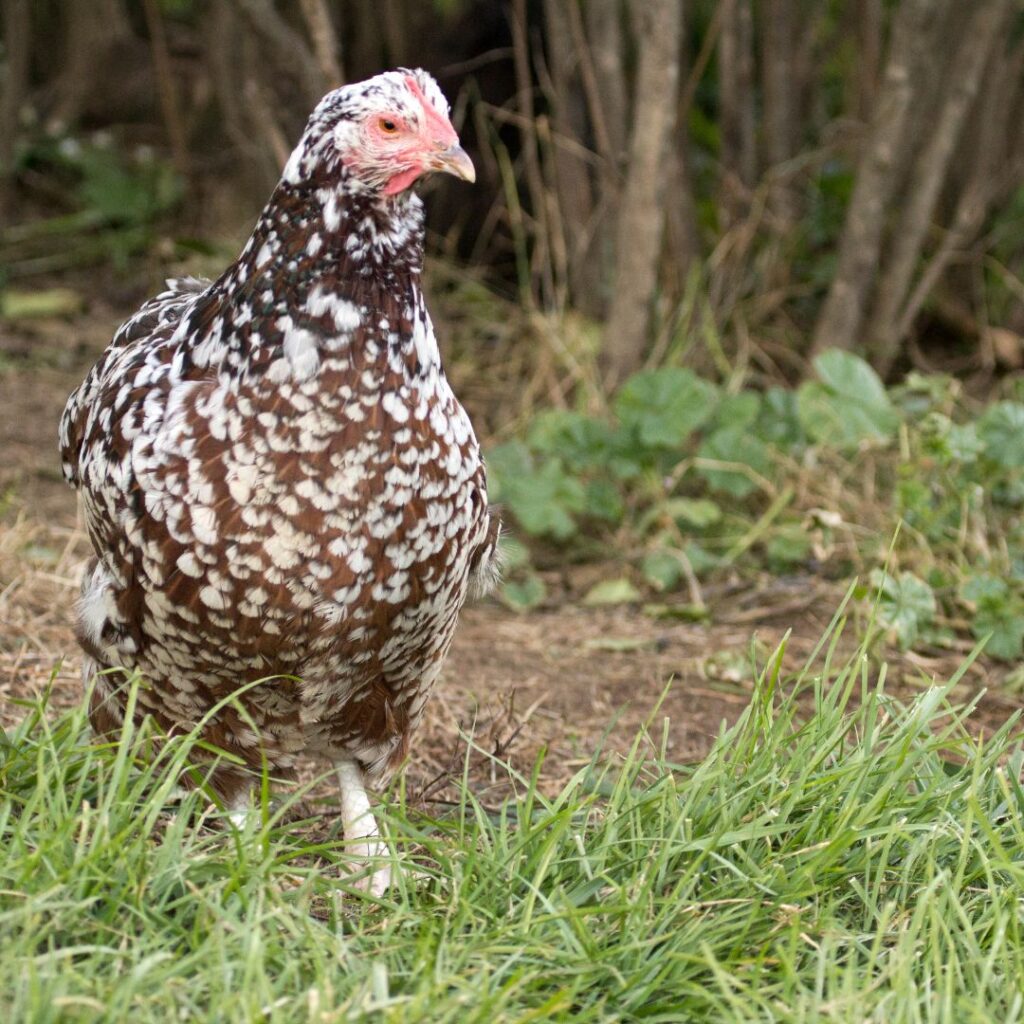
Is The Speckled Sussex Chicken Right For Your Backyard Hobby Farm?
Are you considering adding backyard chickens to your hobby farm? If so, the Speckled Sussex may be a great choice for you. This heritage breed is known for being friendly, docile, and easy to handle. If you are looking for a dual-purpose breed that will lay eggs and produce meat, this breed is excellent egg layers, averaging 4-5 large brown eggs per week. The rooster’s weight of an impressive 9 lbs makes for a good roaster for added protein options in your backyard. Of course, they’re not nearly as large as the Jersey Giants.
In addition to their productive abilities, Speckled Sussex chickens have beautiful coloring with black and white speckled feathers and red earlobes. They are also hardy birds that can tolerate variable weather conditions and thrive in free-range environments.
So, if raising chickens is part of your farming goals, the Speckled Sussex should be on your list of potential breeds to raise for your backyard flock. Happy farming!
ps.. read these tips for raising backyard chickens
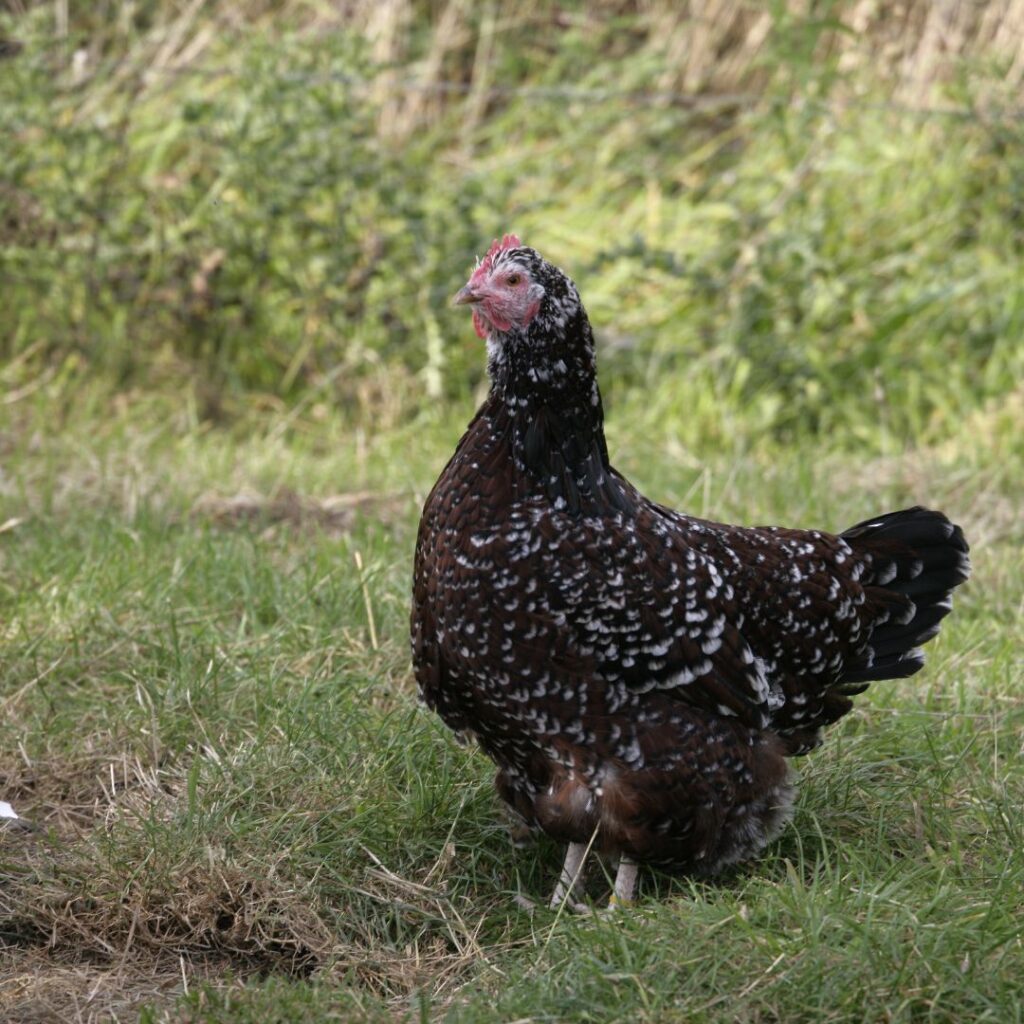
Take a moment to read about the prolific white egg layer (large – X-large eggs!), the White Leghorn and Blue Egg layers, the Araucana, Ameraucana, and Cream Legbar, and the famous Easter Egger, which lay rainbow-colored eggs. We’re sure you’ll enjoy these.
Be Sure To Read About Our 15+ Top Egg Laying Hens.
